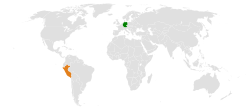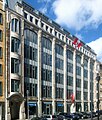Germany–Peru relations
 | |
Germany |
Peru |
|---|---|
| Diplomatic mission | |
| Embassy of Germany, Lima | Embassy of Peru, Berlin |
Germany–Peru relations are the
History
Early history
The first German to arrive in Peru was the
Beginning in 1849, a law passed by
20th century
In 1917, Peru broke off diplomatic relations with Germany during
The Federal Republic of Germany (FRG) opened a Embassy in Lima in 1952. The expropriation of German individuals and companies in Peru was lifted two years later by government decree. Bilateral relations were deepened in the 1960s, and Heinrich Lübke, President of the FRG, visited Peru in 1964. A cultural agreement was concluded two years later, and the German-Peruvian Chamber of Commerce and Industry was established in 1968.[2]
Relations with East Germany (1972–1990)
 | |
East Germany |
Peru |
|---|---|
| Diplomatic mission | |
| East German Embassy, Lima | Embassy of Peru, East Berlin |
East Germany–Peru relations were formally established with the signing of a treaty on December 28, 1972, between representatives of Peru and the
One year later, both countries signed their first treaty on May 27, 1974. The treaty concerned the exchange of technology and scientific knowledge, including qualified staff. Also signed was a protocol that provided 20 scholarships for Peruvian students for the years 1974 and 1975, as well as a trade agreement. On August 21, a fishing cooperation treaty was signed in East Berlin.[6] On April 30, 1975, two treaties were signed: the first one concerned the establishment of East German companies in Peru and was signed as part of the official visit of Trade Minister Luis Arias Graziani, which took place from April 27 to May 1. The second treaty was a trade agreement.[7]
On September 29, a cultural cooperation agreement was signed, and from October 23 to 25, a Peru–GDR Joint Committee was held in the city of Lima, chaired by Peruvian Trade Minister Felipe Estremadoyro and East German Trade Viceminister Gerd Moenkemeyer.
On June 14, 1988, the final act of the meeting held in Berlin between the president of the Institute of Foreign Trade of Peru, Dr. Enrique Cornejo, and the Minister of Foreign Trade, Dr. Gerhard Beil, was signed. On April 24, 1990, an executive programme for cultural cooperation was created.[11] On October 3, the unification of West and East Germany was approved, with the Peruvian Chancellery receiving a note on October 17, recognising the treaty signed on August 31.[12]
Relations since 1990
After
Economic exchange
Both countries have established close economic ties, and a
Germany provides economic aid and technical assistance in Peru. The joint partnership focuses on the environment, good governance, and sustainable urban development to help the country move closer to OECD standards.[16]
High-level visits
High-level visits from Germany to Peru[13]
- President Heinrich Lübke (1964)
- Viceminister Friedman Clausnitzer (1973; representing the GDR)[17]
- Bundestag President Wolfgang Thierse (2004)
- Parliamentarians Anette Hübinger, Wolfgang Wodarg and two more (2007)
- Parliamentarians Ute Granold, Alois Karl, Florian Toncar, Volker Beck and others (2007)
- Congressman Jürgen Klimke (2007)
- Minister Heidemarie Wieczorek-Zeul (2008)
- Minister Frank-Walter Steinmeier (2015)
- President Joachim Gauck (2015)
High-level visits from Peru to Germany[13]
- Minister Luis Arias Graziani (1975)
- Minister Enrique Cornejo (1988)
- President Alejandro Toledo (2003)
- First Lady Eliane Karp (2004)
- Minister Hernán Garrido Lecca (2007)
- Minister José Antonio García Belaúnde (2007)
- President of DEVIDA Rómulo Pizarro (2007)
- Minister Pedro Cateriano (2015)
Culture and education
There are numerous cultural contacts between Peru and Germany. In
In education, there are close contacts and numerous bilateral university cooperations. The
Diplomatic missions
- Germany has an embassy in Lima.
- Peru has an embassy in Berlin and consulates-general in Frankfurt, Hamburg and Munich.
-
Embassy of Peru in Berlin
-
Embassy of Germany in Lima
See also
- German Peruvians
- List of ambassadors of Peru to Germany
- List of ambassadors of Germany to Peru
- List of ambassadors of Peru to Austria
References
- ^ a b c d "Germany and Peru: Bilateral relations". German Federal Foreign Office. Retrieved 25 October 2022.
- ^ a b c d e "Deutsch-peruanische Beziehungen – pangloss.de". www.pangloss.de. Retrieved 25 October 2022.
- ^ "German Immigration and Adaptation to Latin America". Retrieved 4 October 2022.
- ^ Novak 2004, p. 157–159.
- ^ "Ausgabe vom 08.08.1973 § Lima". Neues Deutschland. Retrieved 17 December 2022.
- ^ Novak 2004, p. 159–160.
- ^ Novak 2004, p. 170.
- ^ Novak 2004, p. 170–171.
- ^ Novak 2004, p. 185.
- ^ Novak 2004, p. 186.
- ^ Novak 2004, p. 199–200.
- ^ Novak 2004, p. 207–209.
- ^ a b c "Politíca". Botschaft der Republik Peru in Deutschland.
- ^ a b "Peru – Germany: A business relationship surviving times of crisis". www.veritradecorp.com. Retrieved 25 October 2022.
- ^ "Rangfolge der Handelspartner im Außenhandel" (PDF). Statistisches Bundesamt. Retrieved 30 September 2022.
- ^ Amt, Auswärtiges. "Deutschland und Peru: Bilaterale Beziehungen". Auswärtiges Amt (in German). Retrieved 25 October 2022.
- ^ Novak 2004, p. 159.
Bibliography
- Novak, Fabián (2004). Las relaciones entre el Perú y Alemania (1828–2003) (in Spanish) (1st ed.). Lima: ISBN 9789972426346.




